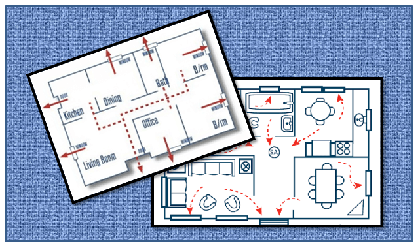 Stop reading right now.
Stop reading right now.
Look up. Look around.
What are TWO WAYS you could get out of the room?
- Will that window open?
- Can you really squeeze through?
- Can you get down outside or do you need a ladder?
Did you have to pause and consider?
I hope not! These are answers you should know before anything happens.
In fact, everyone in your family should know the answers to these questions BEFORE an emergency happens.
Are you leaving your children defenseless?
Unless you point these exits out, your children will never think of them. In an emergency, they will likely run to try to find YOU, even if evacuating would save them.
Here’s an exercise you can do on a Saturday that will answer questions and give you all a much better sense of security.
Design your Home Evacuation Plan together.
It’s a step by step process that everyone in the family takes part in. You’ll need a pad of paper and some colored pencils. And one BIG piece of paper to assemble everything on.
Step 1. Sketch a plan of your home.
One sketch for each floor, or, if your young children are part of the exercise, let each child sketch a separate room. Approximate sizes are fine.
Be sure all doors and windows are marked on the plan.
Combine separate pieces into one master plan. (You can redraw or even cut and paste.)
Step 2. Mark at least two exits from each room on your plan.
Plan in hand, take a walk from room to room. Mark potential exits. You may want to use two colors, one for PRIMARY and the other for SECONDARY exits. You may be able to get out, but can all the children? What about grandmother?
If you need special equipment to escape (a ladder), note that on your plan and mark where it is stored. (Obviously, if you don’t already have the equipment, start a shopping list on a separate piece of paper! More resources below . . .)
Step 3. Note the location of special safety shut-offs for your house.
Keep touring the house. Mark where utility shut-offs are located. Does everyone know when and how to shut off the water? The gas? Again, is a special tool required, like a wrench? Note where it is stored.
Where are the electrical shut-offs? There may be more than one panel. Talk about under what conditions you would shut off the electricity.
Step 4. Where are emergency supplies kept?
In particular, note on your plan the location of fire extinguishers, flashlights and lanterns, and first aid kits. (You can use icons if your plan is getting crowded.)
Where are your evacuation/survival kits stored?
Step 5. Last step: mark on your plan the family’s emergency meeting place — OUTSIDE of the house.
On the sample plan below, the family has designated a particular tree as the meeting place. Be sure the meeting place is far enough away from the house to keep people safe in case there’s a fire. You may want to label a second meeting place if the first one isn’t reachable, even though the second place may be off the map.
 (Thanks to the Regional Municipality of Wood Buffalo, Alberta, Canada for this drawing.)
(Thanks to the Regional Municipality of Wood Buffalo, Alberta, Canada for this drawing.)
A few more thoughts to help drive the point home:
- Save and review your plan from time to time, particularly if you add new rooms, new equipment, etc.
- Take a photo of the plan and share it with other family members (or maybe even with students at a show-and-tell session at school) to see if others will be inspired to follow suit.
- If you will be shopping for emergency equipment, you may find more info in some of our special Advisories, listed below.
Can you get this done before the month is over?? Good luck!
Virginia
Your Emergency Plan Guide team
More Resources from Emergency Plan Guide:
Escape ladders: Your healthy 12-year-old can get down any type of ladder, but what about others in the family? We’ve looked at many of the escape ladders and think that the Werner, 2-story version is a good place to start your shopping. It can carry more than one person at once. Here’s the link to Amazon: Werner ESC220 Fire Escape Ladder, Two Story (Be sure to look at the “product page” and scroll through the images to get a better idea of what the ladder is like.)
Fire extinguishers: We actually experienced a kitchen fire and used the extinguisher we’d just put in place! Read the story and learn more about the different types of extinguishers. A good all-purpose extinguisher is this one, made by Kidde: Kidde 466227 ABC Pro Multi-Purpose Dry Chemical, Commerical and Industrial Fire Extinguisher, UL Rated 1-A, 10-B:C
First aid kits: Most kits you buy are woefully lacking. But you can start with a purchased one and add your own. We held a neighborhood meeting to discuss first aid kits — read about it here — and my search on Amazon for a good starter yielded this one by AAA: AAA 4180AAA 121-Piece Road Trip First Aid Kit
Don't miss a single Advisory.
Thank you for subscribing.
Something went wrong.
